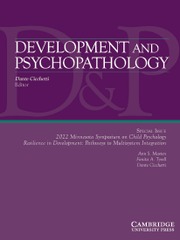Article contents
The serotonin transporter gene is a substrate for age and stress dependent epigenetic regulation in rhesus macaque brain: Potential roles in genetic selection and Gene × Environment interactions
Published online by Cambridge University Press: 15 October 2012
Abstract
In humans, it has been demonstrated that the serotonin transporter linked polymorphic region (5-HTTLPR) genotype moderates risk in the face of adversity. One mechanism by which stress could interact with genotype is via epigenetic modifications. We wanted to examine whether stress interacted with genotype to predict binding of a histone 3 protein trimethylated at lysine 3 (H3K4me3) that marks active promoters. The brains (N = 61) of male rhesus macaques that had been reared in the presence or absence of stress were archived and the hippocampusi dissected. Chromatin immunoprecipitation was performed with an antibody against H3K4me3 followed by sequencing on a SolexaG2A. The effects of age, genotype (5-HTTLPR long/long vs. short), and stress exposure (peer-reared vs. mother-reared) on levels of H3K4me3 binding were determined. We found effects of age and stress exposure. There was a decline in H3K4me3 from preadolescence to postadolescence and lower levels in peer-reared monkeys and no effects of genotype. When we controlled for age, however, we found that there were effects of 5-HTTLPR genotype and rearing condition on H3K4me3 binding. In a larger sample, we observed that cerebrospinal fluid 5-hydroxyindoleacetic acid levels were subject to interactive effects among age, rearing history, and genotype. Genes containing both genetic selection and epigenetic regulation may be particularly important in stress adaptation and development. We find evidence for selection at the solute carrier family C6 member 4 gene and observe epigenetic reorganization according to genotype, stress, and age. These data suggest that developmental stage may moderate effects of stress and serotonin transporter genotype in the emergence of alternative adaptation strategies and in the vulnerability to developmental or psychiatric disorders.
- Type
- Articles
- Information
- Development and Psychopathology , Volume 24 , Issue 4: Contributions of the Genetic/Genomic Sciences to Developmental Psychopathology , November 2012 , pp. 1391 - 1400
- Copyright
- Copyright © Cambridge University Press 2012
References
A correction has been issued for this article:
- 24
- Cited by
Linked content
Please note a has been issued for this article.




